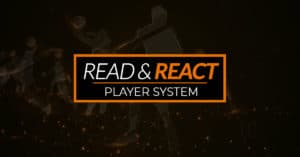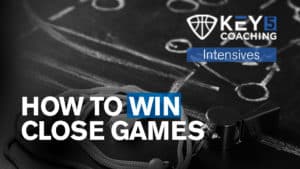Last week we shared the ‘5 W’s of Pick & Roll Defense’ and promised to share five ways to defend the ballscreen. Before we deliver on all five, we must first note that the age and athleticism of the players you are coaching should be factored in when deciding how you want to defend ballscreens. Trying to run all five of these schemes may be too much for your team or your level, pick one scheme below and master it before adding additional options.
Weak
Weak is a term and methodology that is highly effective when implemented defending middle pick & rolls. Weak means that the defense attempts to always force the ball-handler to his/her left hand. The defending “big” must first yell out “Weak, Weak, Weak” (E.L.C.) and the on-ball defender must get into the ball and take away the dribblers’ right hand. The defending big’s aggressive will depend on your scheme (based upon personnel). Why do I think this technique is so efficient?
- Your defenders always know how to guard the middle pick & roll because it is always going the same direction and this will help improve the efficiency of your rotations.
- In today’s game, bigs are getting smarter and smarter and are great at quickly changing their angles, making the defending big sometimes irrelevant. By Weak’ing, you take this away.
- Unless we are talking about the elite basketball players, which are few and far between, most right-handed basketball players (especially at the high school and youth levels) are not as confident dribbling with their left hand. Now you are probably asking, what about left-handed players? Refer to Point #1.
You can also “Weak” ballscreens set on the side with Icing/Blueing.
Weak can be combined with all five of the schemes listed below.
Show
A Show will most likely be used when a shooter is setting the ballscreen. This type of scheme allows the defense to be aggressive, while also getting back to the screener who is potentially popping. The defending big must meet the ball at the level of the screen and force them to make a retreat dribble uphill (towards half-court). The on-ball defender must use their top foot and arm to squeeze above the screen and below their teammate to get back in front of the ball. Show’ing is all about timing, the Show’er must wait until his or her teammate is back (via communication), but they cannot stay attached to the ball too long to give up a wide open throwback or force a full rotation.
Blitz
The setup of a Blitz is identical to the Show. The only difference is both defenders stay on the ball with active feet and hands until it is passed out of the trap. The defending big must do a great job moving their feet and preventing the ball from getting outside their high hip and turning the corner. A Blitz would be used versus a great player to take them out of the play. It is essential that when blitzing, that the remaining three defenders know their job(s) and communicate them clearly throughout the action.
Zone
Zone is a technique used vs a player that is great at attacking the rim but has a decent jump shot. Depending on the location of the screen, the on-ball defender should fight over top to get back in front (unless the location is beyond shooting range and can go under). The defending big needs to be at the level of the screen and close enough to touch the screener, “up to touch”, while remaining in a position to keep the ball in front; preventing the ball from turning the corner.
Drop
Drop is a scheme mostly used when the defending big is not very quick and/or the ball-handler is not a very good shooter. For example, many teams will Drop vs Rajon Rondo because of his inconsistency behind the 3-point line. The goal behind Dropping is to prevent the ball-handler from reaching the rim. Inevitably as the coach you are ok with the player taking an open (or late contested) jump shot.
Squeeze
The fifth and final scheme to defend a ballscreen is called Squeeze (many coaches also call this a Jam or Lift). Similar to the Drop, a Squeeze is effective versus a player who is not a great shooter deep from range. The defending big’s job is to “squeeze” up on the screener and legally move them closer to the ball to allow the on-ball defender to cut behind, beating the ball to the spot. If you noticed in the Drop, this allows for a harder rotation on a screener who pops or makes a short roll. The Squeeze allows the defense to maintain contact with the screener. A Squeeze is also great against ballscreens that are set beyond the arc by a screener who illegally rolls to the basket, taking out the on-ball defender trying to get under.














